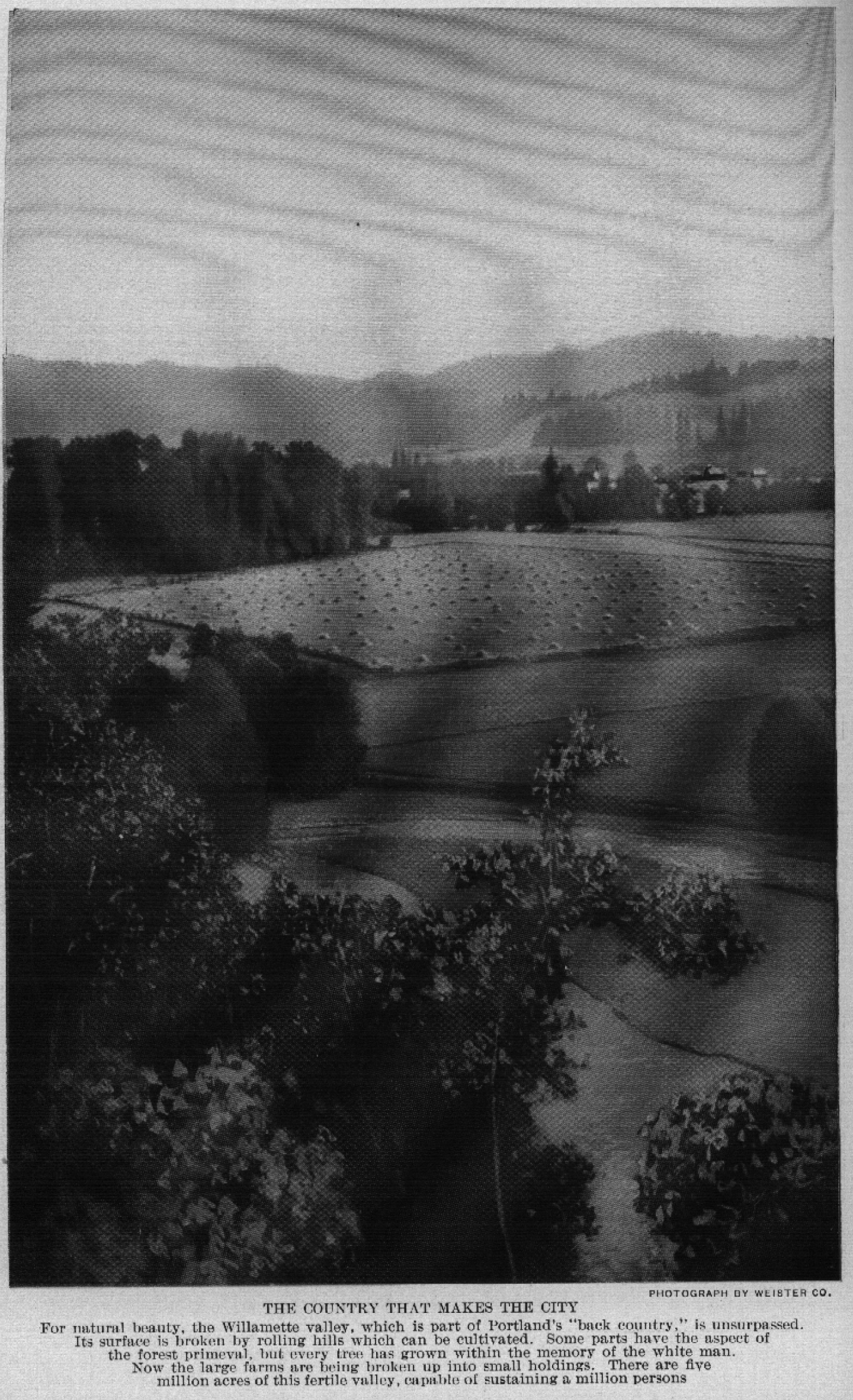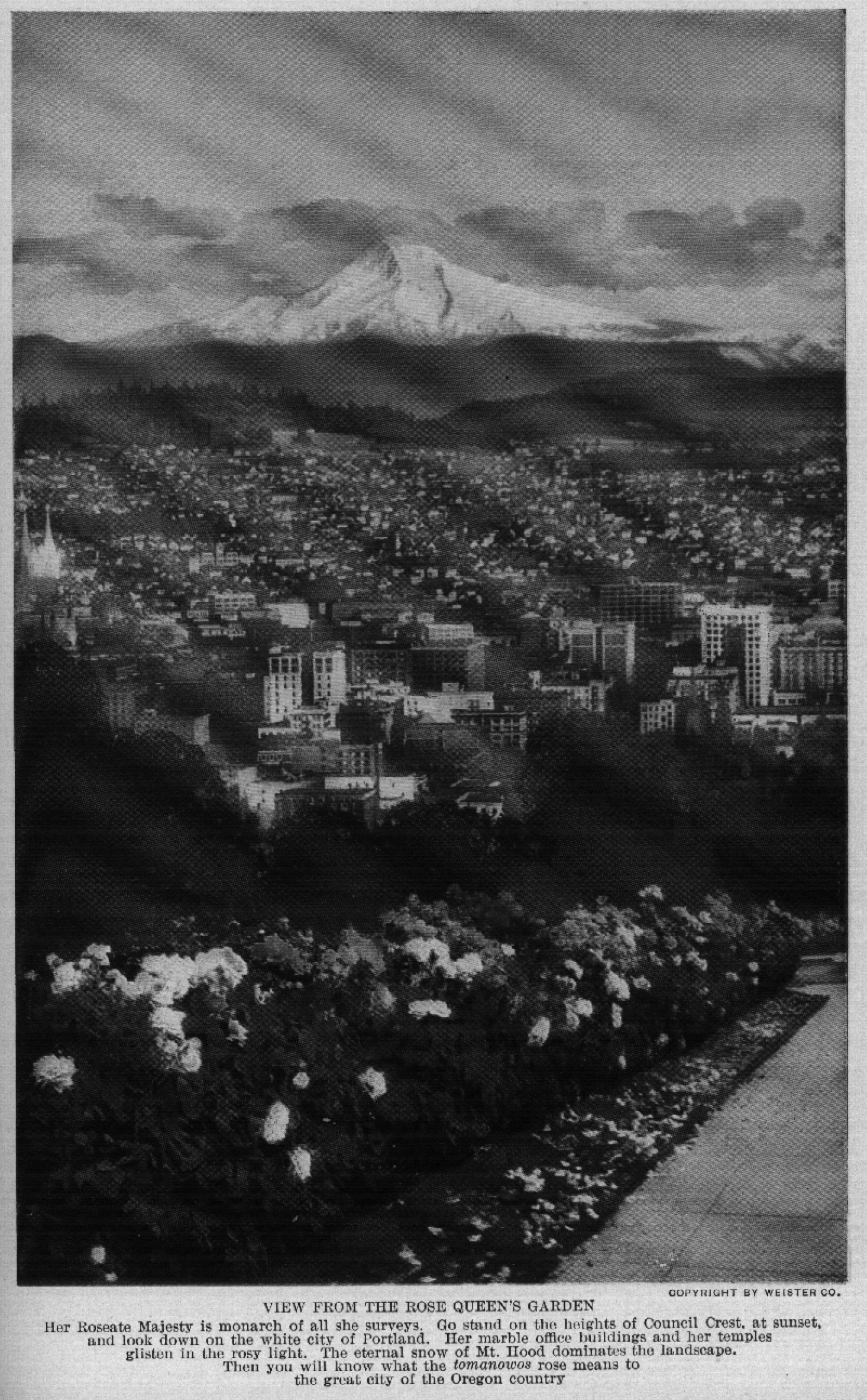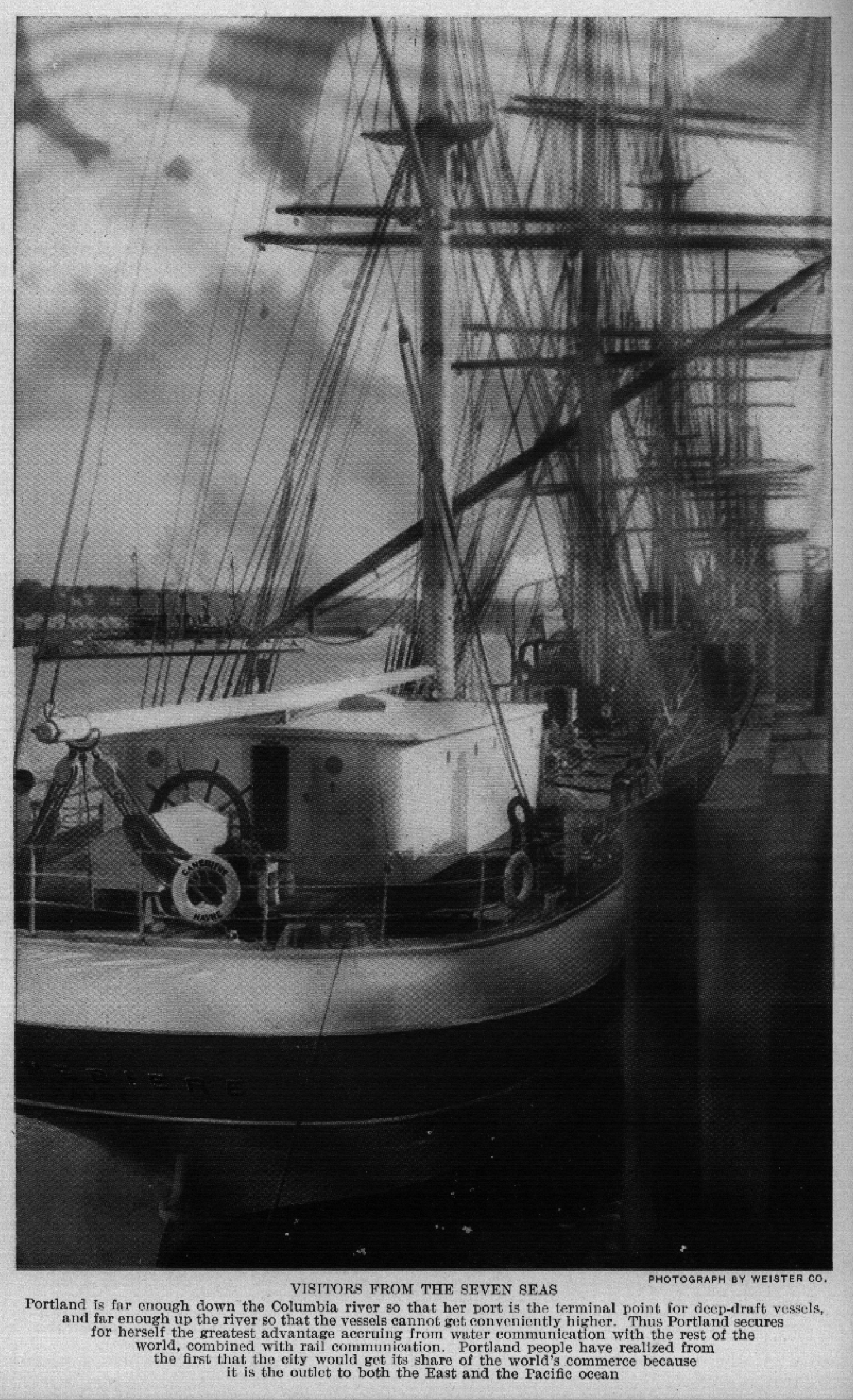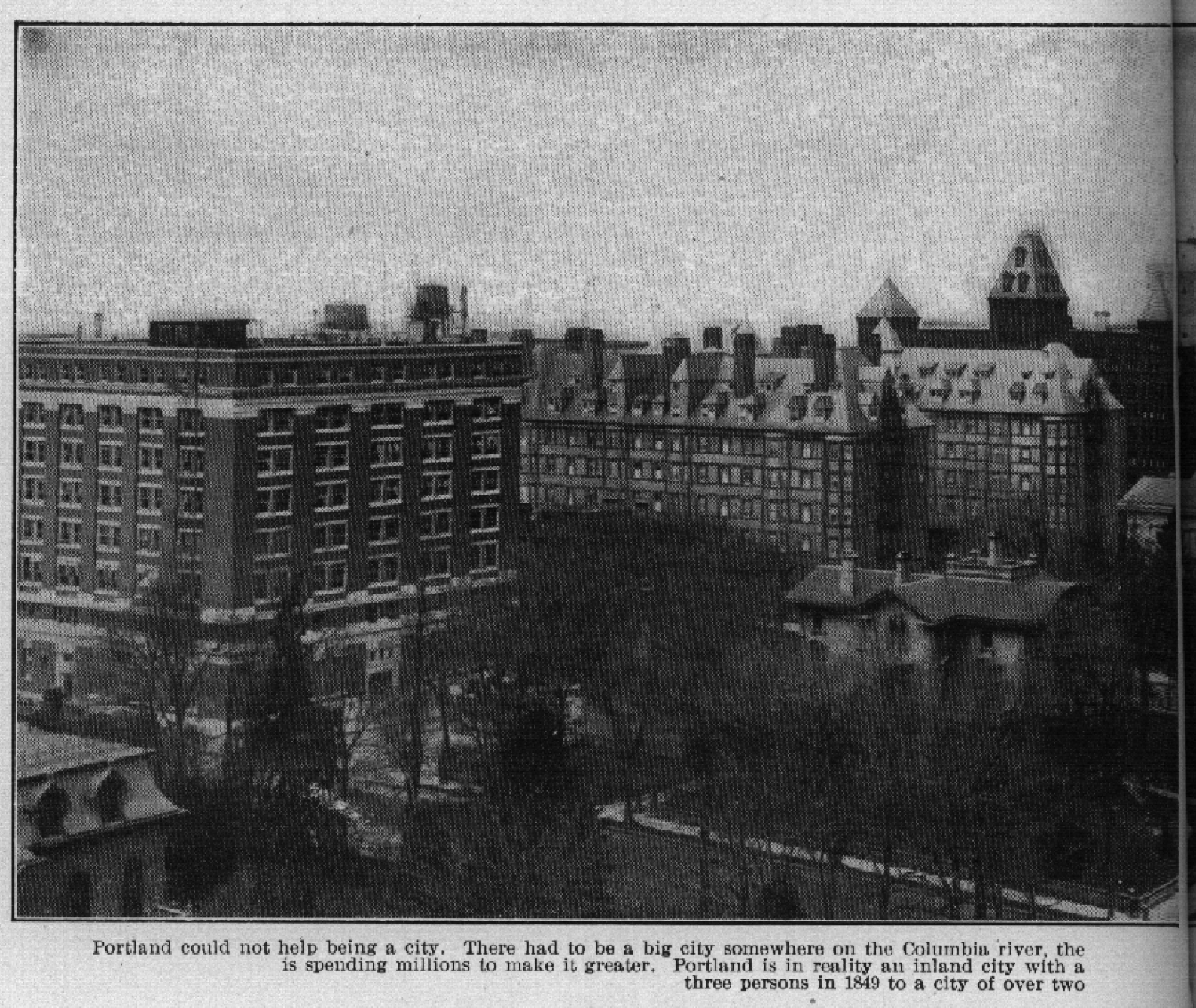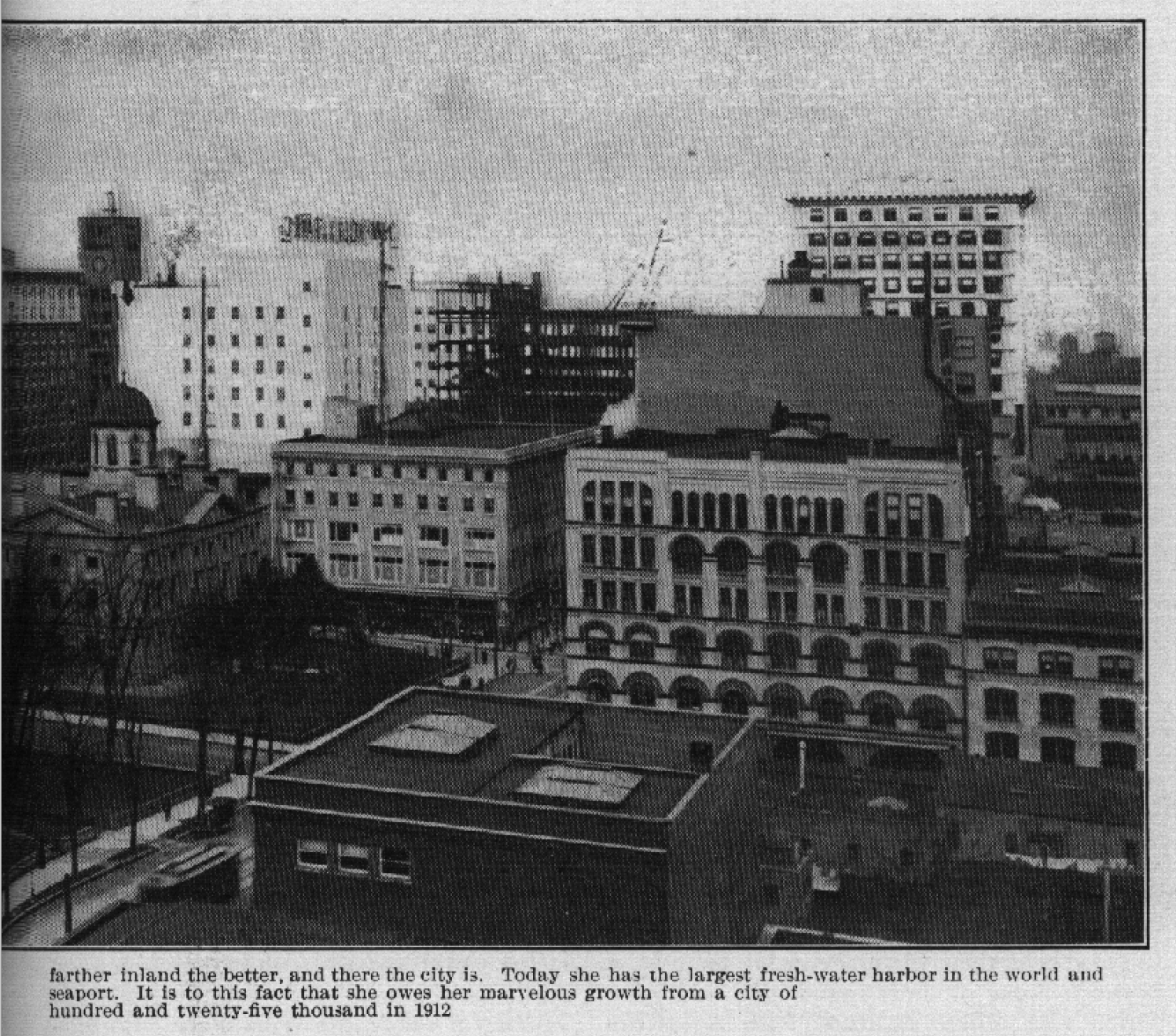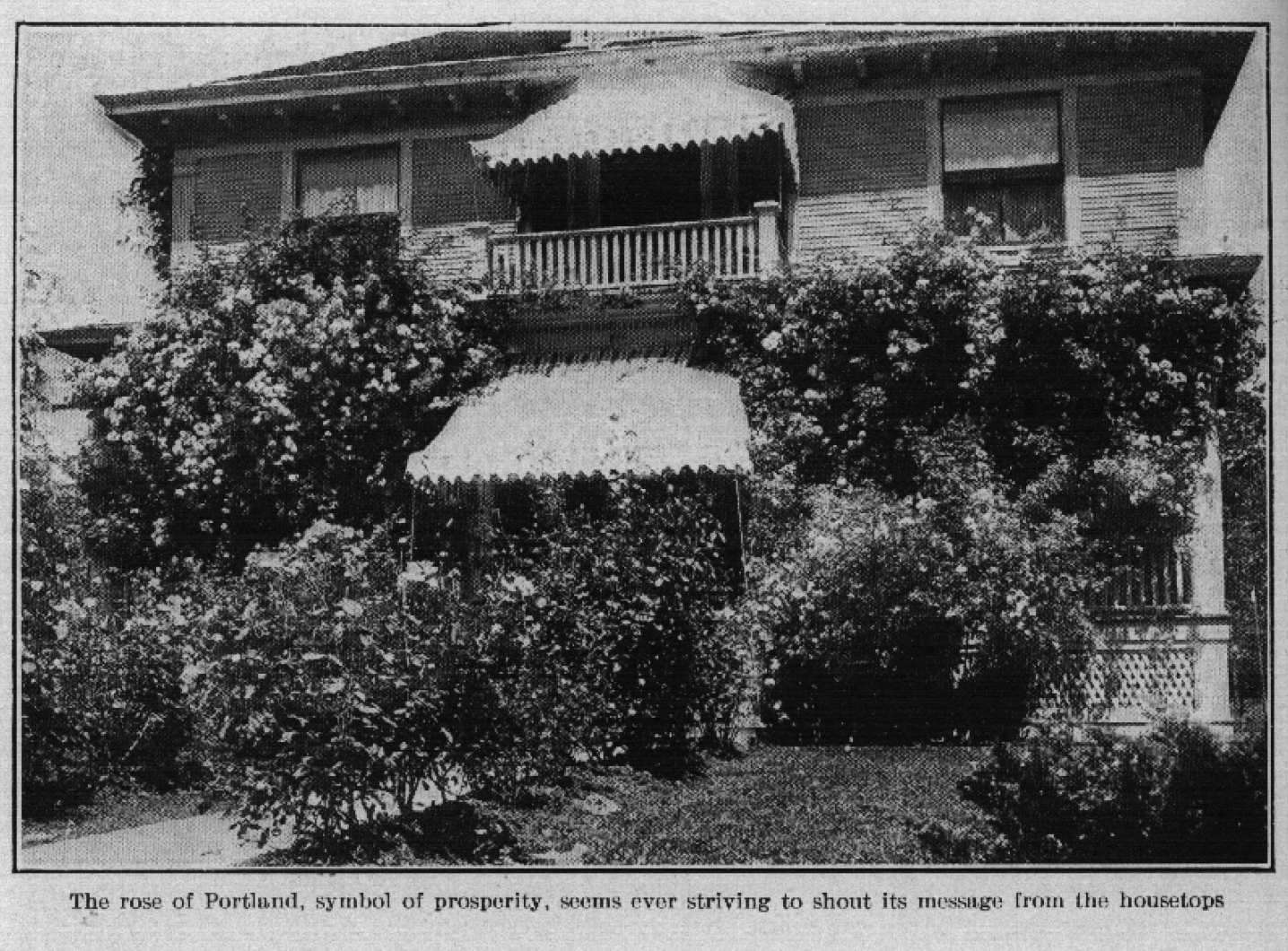The breath of Chinook.
Evans, Samuel M.. "The breath of Chinook." Sunset 28, no. 5
(May 1912): 519-532.
[https://library-projects.providence.edu/rosarium/view?docId=tei/rg0062.xml]

The legend of the tomanowos rose, how it came to exist and what it means to the people of Portland who do it honor in the annual rose festival
For many suns and many moons after Sahle, the Great Spirit, destroyed the Bridge of the Gods and turned Loo-wit, Klickitat and Wiyeast into the great snow peaks that white men call Mount St. Helens, Mount Adams and Mount Hood, the Willamette Valley lay bare and devastated. With the destruction of the great natural bridge across Great River (the Columbia), had come the breaking up of the powerful federation of Wauna and the death of the great war-chief, Multnomah, and then the plague that destroyed the powerful tribe of the Willamettes. For the Bridge of the Gods had been tomanowos (a good sign from the gods) to Multnomah and his warriors, and when it was destroyed they no longer prospered. The fierce Cayuses, Bannocks and other tribes from Umatilla (Wind-drifted Sands) in the East, and the Klamaths, Modocs and other warriors from the South, had captured and taken into slavery the few Willamettes that survived the great plague, and no one lived in the Willamette Valley. No Indians camped along Great River and the grasses grew high in the valleys again because no braves burned them off every year to drive big game in the mighty hunt. The five brothers who lived at Walla Walla (the meeting of the waters) and who caused the cold winds to blow, had killed the three Chinook brothers who lived in the West, and who caused the warm winds to blow. But the eldest of the three dead Chinook brothers had a son. And his mother brought him up to believe that he must obtain revenge for the death of his father and his uncles. After a while, young Chinook became very strong. The he went up Great River until he came to Umatilla, where the Walla Walla brothers lived. He killed four of them and the fifth yielded to him and promised never again to blow hard enough to freeze the people.
The Chinook went to his home in the western mountains. As he passed through Willamette Valley he blew his warm breath on the hills and on the plains, and the desolation vanished and roses sprang from the soil. The rose became strong tomanowos to the peoples who afterward lived in the Willamette Valley, just as the Bridge of the Gods had been tomanowos to the ancient inhabitants of the valley. But, whereas the bridge stood for warlike strength and prowess, the rose signifies the breath of Chinook, the Warm Wind, who is the Great Kindly Spirit of the Northwest. And every year Chinook blows his warm breath on the hills and valleys, and roses bloom. That is how the rose came to be in the Valley of the Willamette and why the people of that country have such strong tomanowos and prosper so much through the yielding up of rich bounty by the soil.
This is substantially the beautiful Indian legend that explains why the rose grows naturally in the Willamette Valley, Oregon. Whether or not it was ever told around the tepees of the Willamette Valley in exactly the form in which it appears here, is of no consequence. The Indian tribes of Oregon explained most of the natural phenomena with picturesque tales not unlike the mythology of the ancient Greeks, and the rose, which has its natural habitat in the warm well-watered valleys of central Oregon, was to them a sign of the benevolence of the gods. More than that, it was tomanowos—a special sign from the gods that they would always be prosperous.
The believers in tomanowos or totem worship have vanished from the valleys of Oregon or have been confined in small Indian reservations. But their places have been filled with rosarians, devoted followers of the culture of the rose. And every year Portland, the queen city of the mighty Oregon country, does homage to the rose with ceremony more gorgeous than ever the Indians dreamed of, but in the same spirit of recognition that while the rose blooms in the country about Portland, there is prosperity and happiness. From June 10th to 15th of this year, the citizens of Portland will give themselves over to the celebration of their Sixth Annual Rose Festival. It is an institution established after the Lewis and Clark Exposition had shown the advertising value of Portland’s wonderful rose gardens. But, while Portland is fully alive to the advertising value of the festival, the festival itself is different to any other show of the kind in the country. It means something different to the Tournament of Roses at Pasadena, for instance, which is held to show the world that roses thrive there in January. It is not exactly like the Mardi Gras at New Orleans. The nearest thing to it is the Golden Potlatch held annually at Seattle. The Portland Rose Festival is a celebration of the Oregon country, and the rose is its main feature because the rose is the flowered expression of the bounty of nature, tomanowos of central Oregon. Portlanders celebrate their rose festival very much as a man who struck it rich would celebrate his prosperity on Broadway, New York. In the latter case, the lucky fellow usually goes from café to café drinking wine and giving away gifts. He wants others to know that he’s prosperous and the best way he can impress them with this fact is to give things away. The spirit of the Portland celebration is exactly the same, only it is a sane and proper rejoicing that would not shock the sensibilities of the sternest Puritan. And the gifts that are given away are roses—carloads and carloads and carloads of them. The Indian never spoke of his tomanowos. The rosarian not only speaks of it, but he presses it upon you. From the first day of the celebration to the last, the rose, tomanowos of Portland, is the predominating note. There are day and night parades and celebrations, and everywhere are roses. You would not think that so many roses grew in all the world. Decorated vehicles that take part in the parades are not used for that occasion only; they are used throughout the entire festival, and each half day they are covered with a fresh garland of roses. Children dancing around May-poles with stringers of roses, rose-decorated motor cars and rose-decorated buildings—these are only the beginnings of what Portland does with roses. There is the annual show of the Portland Rose Society at which prizes are given for the finest displays of the roses grown in Portland. Rosarians from England—and they grow some roses in England, by the way—have gasped at the exhibition. But I can give only a faint idea of the rose festival. You will have to see it to appreciate it. That it is conducted by George L. Hutchin, known all over the United States as publicity man and advertiser de luxe and a provider of real entertainment, is enough. If you’ve been to any of the World’s Fairs during recent years or heard about them, you know about Hutchin.
The significant thing about the rose festival is the fact that the rose is tomanowos of Portland and of the great central Oregon country around Portland, that gives the city its life and its being. And that is the vital part of the show.
With the exception of San Francisco, Portland is the one city on the Pacific Coast that couldn’t help being a city. That’s not saying that there is no reason for the existence of the other cities. Far from it. There are reasons and reasons why the other cities exist, and chief among them is the indomitable spirit of their inhabitants. And there are many good reasons why cities yet undreamed of will rise like magic on the Pacific Coast. But in the case of Portland, there simply had to be a big city somewhere on the Columbia river, the farther inland the better, and there the city is. That’s the answer to the question "Why is Portland?" As for outside help, there was none. The United States Government did everything to retard the development of Oregon except give it away to a foreign power, and the solons at Washington came very near doing that. That’s all ancient history now, but it goes to show that when Destiny points her finger, nothing—not even the Congress of the United States—can change her decree. And Destiny selected Portland as her child.
Though Captain Robert Gray in the ship Columbia discovered in 1792 the river that bears the name of his vessel; though William Clark and Meriwether Lewis in 1805-6 made their expedition from St. Louis into the Northwest and discovered the rivers that bear their names; though the expedition sent out by John Jacob Astor founded Astoria as an American post at the mouth of the Columbia river in 1811, it was not until 1846, when the cry of "54:40 or Fight" was raised, that the government at Washington woke up. Meanwhile, the British had captured Astoria during the War of 1812 and changed its name to Fort George and refused to surrender it again in accordance with the plain terms of the Treaty of Ghent. Indeed, the United States did not try to regain possession of Astoria until 1817, when the war sloop Ontario sailed to the fort and made a half-hearted demand for surrender. The refusal of the British did not worry Washington very much. Astoria was a long way off from Pennsylvania avenue. And so a "joint-occupancy" agreement was entered into whereby nominal possession of the place was given to America while actual possession remained in the hands of the British fur-trading company that had seized it in 1813. The "joint-occupancy" agreement was renewed in 1828 and remained in force until the Oregon Territory dispute was settled in 1846. And from 1813 until that time, the American pioneers in the Oregon country were under the rule of the governor of a British corporation. Only the wise administration of Dr. John McLoughlin, who ruled the affairs of the Hudson’s Bay Co. in the Northwest between 1823 and 1845, prevented serious conflict between the handful of Americans who had settled Oregon against the wishes of Congress and the British traders.
In 1829, Hall J. Keeley earned for himself the sneers and laughter of his friends by incorporating in Massachusetts "The American Society for the Settlement of the Oregon Territory," and this organization co-operated with the few Americans then in the wilderness of the Northwest in trying to get Congress to extend the protection of the Stars and Stripes over Oregon. In 1831 a memorial to Congress asking for American rule in Oregon was tabled with silence. The next year four Flathead Indians arrived at St. Louis, having traveled overland from Montana to ask that someone be sent to teach the Indians about the "white man’s God." In 1835 the ship Mary Dacres carried the first party of missionaries into Oregon. The missionaries were the first real American settlers; they built homes and established friendly relations with the Indian tribes. From the foothold they secured for American interests, the Washington government received considerable moral support when the issue with England was finally settled. In 1839 another petition signed by J. L. Whitcomb and thirty other American residents of Oregon was presented to Congress. When Senator Lewis F. Linn read it in the Senate Chamber on January 28th, it was greeted with shouts of laughter. The thirty-one pioneers had had the temerity to say "We flatter ourselves that we are the germ of a great state." It was highly amusing. Other similar petitions for the protection of the United States flag were sent to Congress in 1840 and in 1843. Speaking of the petition of 1843, one of the senators—I will not mention his name—said "Why, sir, of what use will this territory be for agricultural purposes? I would not for that purpose give a pinch of snuff for the whole territory. I would to God we did not own it." The descendants of that senator pay handsomely today for Oregon apples, and not a few of the apples are raised by farmers who left his state to make a better living from the rich soil of Oregon.
Despairing of ever obtaining American protection, the Americans in Oregon established their own government in 1843. In February of that year they met at Champoeg and established a constitution by a vote of 52 to 50. This stood until the passage of the territorial act by Congress in 1848 when Oregon became American territory in truth and in fact.
I have said that Portland was pre-destined to be a great city. Let’s see why. It is an axiom of commerce that the movement of peoples and goods on the surface of the earth is for the most part in an east and west direction. Only a very small part of the world’s commerce moves in a north and south line. On the Pacific Coast, in that chain of valleys between the Coast Range mountains on the west and the Cascades and Sierra Nevadas on the east, there is considerable movement of goods in a north and south line. But it is the movement of goods into and out of this area in an easterly or westerly direction that really counts in the commerce of the world, which is made up of the exchange of goods between different sections of the earth. Now, between the Missouri river and the Pacific ocean, three great barriers interpose themselves to make the transportation of persons and goods difficult. These are, first, the Rocky mountains, second, the Sierra Nevadas and Cascades, which constitute the second barrier, and last the Coast Range. The Coast Range is broken by Puget Sound, the Columbia river, San Francisco bay and several other smaller bodies of water that constitute greater or less harbors and all of which give access to the Pacific ocean through the Coast Range mountains. There are no water-level passes through the Rocky mountains. All goods must be hauled up one side of the barrier and down the other through passes of varying altitudes. The middle barrier, that composed of the Sierra Nevadas and the Cascades, is broken at only one point—the place where the mighty Columbia cuts its way through the Cascade mountains, giving practically a water-level pass through this barrier. In all other places, goods must be hauled up one side of the barrier and down the other. The Columbia river, then, gives access not only to the Pacific ocean through the Coast Range barrier but to the East through the Cascades barrier. Nothing could have prevented the building of a great city somewhere on that river.
As to the exact location and the name of the city, it is by the merest shred of circumstance, the flip of a coin—or three flips to be exact—that these factors were decided. Had the coin turned the other way, we should have to be careful to write "Mass." on our envelopes after the word "Boston," and the inhabitants of the "the hub" would have very much the same peeved feeling that comes to residents of Portland, Maine, when a letter addressed to one of them without the name of the state being specified, is sent to the Portland in Oregon—a city four times as large as its godfather, by the way. William Overton and A. L. Lovejoy settled on the banks of the Willamette river near its confluence with the Columbia one day in 1843 and said "Here is to be the big city of the Oregon country." Overton sold out his interest in the town site before more than five trees had been felled, to F. W. Pettygrove from Portland, Maine, and the two new partners built a cabin and surveyed the site of the future city. Then came a dispute as to what the place should be called. Pettygrove wanted to call it Portland, and Lovejoy, who hailed from Boston, wanted to name it after his home city. They flipped a coin three times and Portland, Maine, won—or lost, whichever way you want to look at it. Later, Pettygrove got malaria and became convinced that Portland could not be a great city, just as people sometimes reason in this day. He moved to Puget Sound and established Port Townsend, where he died not very many years ago after he had lived to see Portland grow into a mighty city while Port Townsend was still a small town.
The flip of a coin decided the name of the town, but it did not decide that Portland was to be the principal city on the Columbia. Milwaukee, Wisconsin—the city where many signs are said to read "Here is English spoken" —had a narrow escape from the fate of Portland, Maine. The town of Milwaukee, a few miles above Portland, Oregon, was then the head of navigation for the big vessels of the Pacific Mail Company and the steamer Lot Whitcomb. The little town of Portland struggled along without direct communication with the sea except for occasional visits from the vessels to and from Milwaukee. In 1849 the citizens of the village got together and bought the steamer Gold Hunter, making Portland her home port. She burned too much fuel to be a profitable investment and some of her owners in Portland unwittingly sold the controlling interest in the vessel to San Franciscans who ordered her on a voyage to Central America. She never returned from that voyage and the citizens of Portland waited in vain for their vessel. When they learned what had happened they began negotiations for the purchase of another vessel when the Pacific Mail Company and the Lot Whitcomb agreed to make Portland their terminal port. The Columbia, a palatial vessel for those days, made her first trip to Portland in 1851, and the future of the port was assured. Thus was Milwaukee, Wisconsin, saved. Milwaukee, Oregon, will soon be a part of Portland if the city continues to grow as it has during the past few years.
The purchase of the Gold Hunter came about indirectly through the discovery of gold in California. The news reached Portland months before it reached the eastern part of the United States and it carried the same lure. You have heard of the "days of ’49." Well, the inhabitants of Portland can tell you about the days of ’48. They beat their eastern cousins to it by a year. Some of them found gold and grew rich and others returned with no riches except experience. But nearly everyone went. In January, 1849, there were only three persons left in Portland. Those who returned with experience began straightway to make that experience pay. California needed lumber. The whole town site of Portland was covered with as fine pine timber as grew anywhere in the world. They began to saw logs. The first cargo of lumber taken to San Francisco by the Gold Hunter brought $600 a thousand. A curious part of that cargo was a consignment of a few apples, which sold in San Francisco for five dollars apiece. The rest of the world had begun to appreciate Oregon’s wonderful apples even at that date.
In 1851 Portland was incorporated and held her first town election. There were 140 votes cast, showing that the population of the town was not more than 200. Sawmills and lumber was her main industry. The back country had not yet been opened up. A part of the Willamette Valley was settled when Oregon was admitted as a state in 1859 and Salem was made the state capital, but the principal portion of Portland’s commerce came from the lumber industry. In 1883 the Oregon Railroad and Navigation Company completed its line connecting Portland with St. Paul, and the city at once felt the quickened life that follows the steel pathfinder. Five years later the Southern Pacific line between Portland and San Francisco was completed and Portland began to look like a city. With the completion of the railroads, settlers came into Oregon and began to farm the rich Willamette Valley, and more and more wheat began to figure largely in the exports of the port of Portland. More docks were built to accommodate the outgoing lumber and wheat and the incoming foodstuffs and implements for the new home-makers. And so, by dint of her natural advantages, Portland grew into a city. Today, she has the largest fresh-water harbor in the whole world and is spending millions to make it greater. She is far enough down the river so that the port is the terminal port for deep-draft vessels and far enough up the river so that vessels cannot get conveniently higher. Thus Portland secures for herself the greatest advantage accruing from water communication with the rest of the world as well as rail communication. At the same time, the city is in the midst of a wonderful valley, the Willamette. Portland is in reality an inland city with a sea-port. It is to this fact that she owes her marvelous growth from a city of three persons in 1849 to a city of over two hundred and twenty-five thousand in 1912. And she is still growing. The figures may be greater ere this gets into print.
It has not been a boom growth at all. Portland is eminently a conservative city. Professional boosters have ever found it hard to take root there, because Portland people have realized from the first that the city would get its share of the world’s commerce for the simple reason that it was the natural outlet to both the East and the Pacific ocean. In fact, there was so full a realization of this God-given advantage that until a few years ago even legitimate advertising of the city’s resources was not put out. Several years ago some of the public-spirited men of Portland met to consider ways and means for advertising the city. What came out of that meeting is a lesson for every other city on the Pacific Coast. After several speakers had dwelt upon the necessity for advertising the city, one of the biggest citizens of the town made a short speech. What he said was something like this: "A city is not sufficient unto itself. If we have a productive country back of us, the city cannot help but grow. If we have not, all the advertising in the world will not make a permanent city here or anywhere else. I will not give a cent toward advertising Portland. But I will give ten thousand dollars toward advertising Oregon. We have thousands of acres of rich land in this state awaiting development. When it is developed, Portland will be a great city and not until then." And then he sat down.
That speech struck fire, and the result is the Portland Commercial Club. It is unique in boosting organizations. Though it exists in Portland and is named for the city, it does nothing directly to further the interests of Portland. Ask a member of the club something about Portland and he will begin to talk about Oregon. And that’s right, when you come to think about it. All the commercial organizations in Oregon use the Portland Commercial Club as a clearing house, and thousands of people have been put upon the land through its influence.
And the back country is producing goods that are sent to Portland for distribution to the rest of the world. What is this back country? In reality it consists of the whole state of Oregon, a part of Washington and a part of Idaho. It would require a volume to tell of the growth of this country and the advantages for settlers that it possesses. But I wanted to tell about some of it, so I made a little excursion into the Willamette Valley in which Portland is situated and which is therefore directly tributary to the city. The valley is fifty miles in width and a hundred and fifty miles long. Nearly every foot of it is as fine agricultural land as can be found anywhere in the world and it is only just beginning to be scratched by settlement. There are several fine thriving towns in it and many farms, but that’s only the beginning. The five million acres in this valley will easily sustain a population of a million persons, and that’s not figuring it as closely as Belgium and several other European countries do right now. For natural beauty the Willamette Valley is unsurpassed anywhere. It is not a flat plain as are most of the interior valleys on the Pacific Coast, but its surface is broken by more or less irregularly placed rolling hills, which can be cultivated. The soil is an alluvial loam deposited there by the life-giving waters. Most of the hills and some of the flat places are covered with pine and fir trees that give the aspect of a primeval forest, but every tree has grown there within the memory of the white man. In the old days the Indians burned off the grasses of the valley every year in the great hunt for big game, but when civilization stopped this practice, trees grew. Until a few years ago wheat was the staple crop of the valley and it is still a very important factor in the agricultural life of central Oregon. But the day for extensive agriculture in the Willamette Valley is passing. Before many years it will have passed altogether. Right now husbandry is in the transition stage. The large farms are being broken up into small holdings and fruit, vegetables, berries and forage crops are supplanting the cereals. Near Salem cherries are produced that make the syrup you get at a New York soda fountain.
There also is grown the Oregon prune, the history of which is one of the fascinating romances of agricultural industry. Before a market for the Oregon prune could be secured, it had to be created. The growers sent Mr. H. S. Gile of the Willamette Valley Prune Grower’s Association back East every year with his suit-case stuffed with prunes and the pockets of his overcoat bulging with them. He was shown out of offices and turned away from stores for years but he stuck to it and now the demand for the Oregon prune is greater than the supply. It is not really a prune. It is the Fallenberg plum, the only plum that retains enough sugar to make it palatable after it has been evaporated. It is much larger than the ordinary prune and when dried has a snappy taste that can be secured with ordinary prunes only by cooking them with a lemon. Last year Oregon exported more than twenty-five million pounds of prunes. And they all went through Portland.
The Oregon prune has left a bitter taste in the mouths of some of my Eastern friends who tried prune-raising in the Willamette Valley, lost everything they had in the panic of 1903, sold out and went back home with harsh words for Oregon. I wanted to find out about their experiences and so I went to the farm of Mr. A. L. West of Salem, who is considered one of the most successful prune raisers in Oregon. I learned the answer, all right. I wish there were space to tell Mr. West’s story exactly as he told it to me. He went out to Oregon some years ago at the age of forty to die. His doctors told him that he might live a year at the most and that his wife would not survive him many months. You ought to see him now. He has an orchard for which he has refused $35,000 cash, a home in Salem, an automobile and a bank account, And, most important of all, he and his wife have given the doctors another guess. Neither of them looks in the slightest degree ready to part this life for another forty years; and they feel that way too. West formerly lived in Indiana—never mind the exact place—and with his three brothers he eked out a not too luxurious existence on a farm. In 1893, while he was running a small hardware store, he bought twenty acres of Oregon prune land from a man who came along and sold it to him "sight unseen," as they say in Indiana. The next year he and his wife went to Oregon to get well, but they returned home the next year to die. Only West didn’t die. He got better and took a position as traveling salesman. In 1900 he sold out his interests at home and moved to Oregon again. He had his twenty acres paid for and was in debt. That was all the start he had. Even the Salem banks wouldn’t lend him money on his place. They didn’t have faith in those days. But he did. He had lots of it. When his neighbors got disgusted and sold out, he just bought more land. And now he’s "out of the woods." I asked him how he did it.
"By working hard and working every minute of the time" replied he slowly. "You see, I didn’t run into town to see the show or drive around in a side-car buggy. I just stuck to it and worked. I knew it would come out all right."
And that’s about all there is to it. Farming is not sitting down and waiting for the fruit to fall in your lap. It’s work, like anything else. And in the Willamette Valley it pays big. West wouldn’t trade lots with anyone. I talked with another man who had come to Oregon in 1897 with $350 cash. Now he has sixty-five acres of prune land. His crop brought him over three thousand dollars last year.
It’s the same with dairying. Thoroughbred herds are just beginning to come into their own in the Willamette Valley. Kale and vetch are the principal forage crops and alfalfa is raised to a small extent. Irrigation is not necessary, for the Willamette Valley has an annual rainfall of about 45 inches. It is the only large area on the Pacific Coast where irrigation is not a necessity, for Chinook blows his warm breath on the snow-clad mountains every year and brings the warm rains and abundant water. And all this produce is what is making Portland a great city. That’s what the Portland business man meant when he talked about advertising the back country.
And Portland is beginning to realize that she must prepare for a growth even more marvelous than that which she has experienced in the past ten years, if she is to care for this commerce that is swelling her warehouses even now. E. H. Bennett, the great city planner, has prepared a comprehensive plan for a Greater Portland. This has been adopted and is being carried out. The new postoffice building to be erected by the United States Government in the near future, the new county courthouse now under course of construction, and an immense civic auditorium for which bonds have been voted, are all to be at the new civic center. A monster union depot at the proposed transportation center bids fair to be a reality and Portland is now widening some of her streets to serve as laterals in the new scheme of things. The Southern Pacific Company is rushing to completion a new steel bridge across the Willamette river, constructed in accordance with the Bennett plans at a cost of two million dollars. A commission of engineers from the New York Department of Docks and Ferries has just submitted a plan for the improvement of the harbor in accordance with a bond issue of two and a half millions just voted by the city for municipal docks, and the Government of the United States is spending millions more to deepen the channel of the Columbia river and finish the sea-wall at the mouth. By the time the Panama Canal is opened, Portland and Uncle Sam will have expended twenty-five million dollars on the Portland harbor. Twenty-five million dollars was expended in buildings in 1911. Thus is Portland preparing for her share of the commerce that will come with the cutting through the Isthmus of Panama.
Now this has nearly all been about business. Go out onto the hills of Portland’s residence district where the gardens are riotous with roses and you will learn more about the beauties of Portland as a home city than I could tell you in ten pages. At the highest point of the city great streams of water are being thrown against a range of hills to terrace them off for residence purposes. The mud-laded water is conducted down a flume to fill the flats surrounding a lake. The flats will be used for factory sites and the terraces for residences. Thus ever do business and the making of homes go hand in hand. Stand on the heights of Council Crest at sunset and look down on the white city of Portland below, her marble office buildings and her temples glistening in the sun, with the three snow-clad peaks of Mt. St. Helens, Mt. Adams and Mt. Hood towering in the distance and dominating the landscape, and then you will know what the tomanowos rose means to the great city of the Oregon country.

